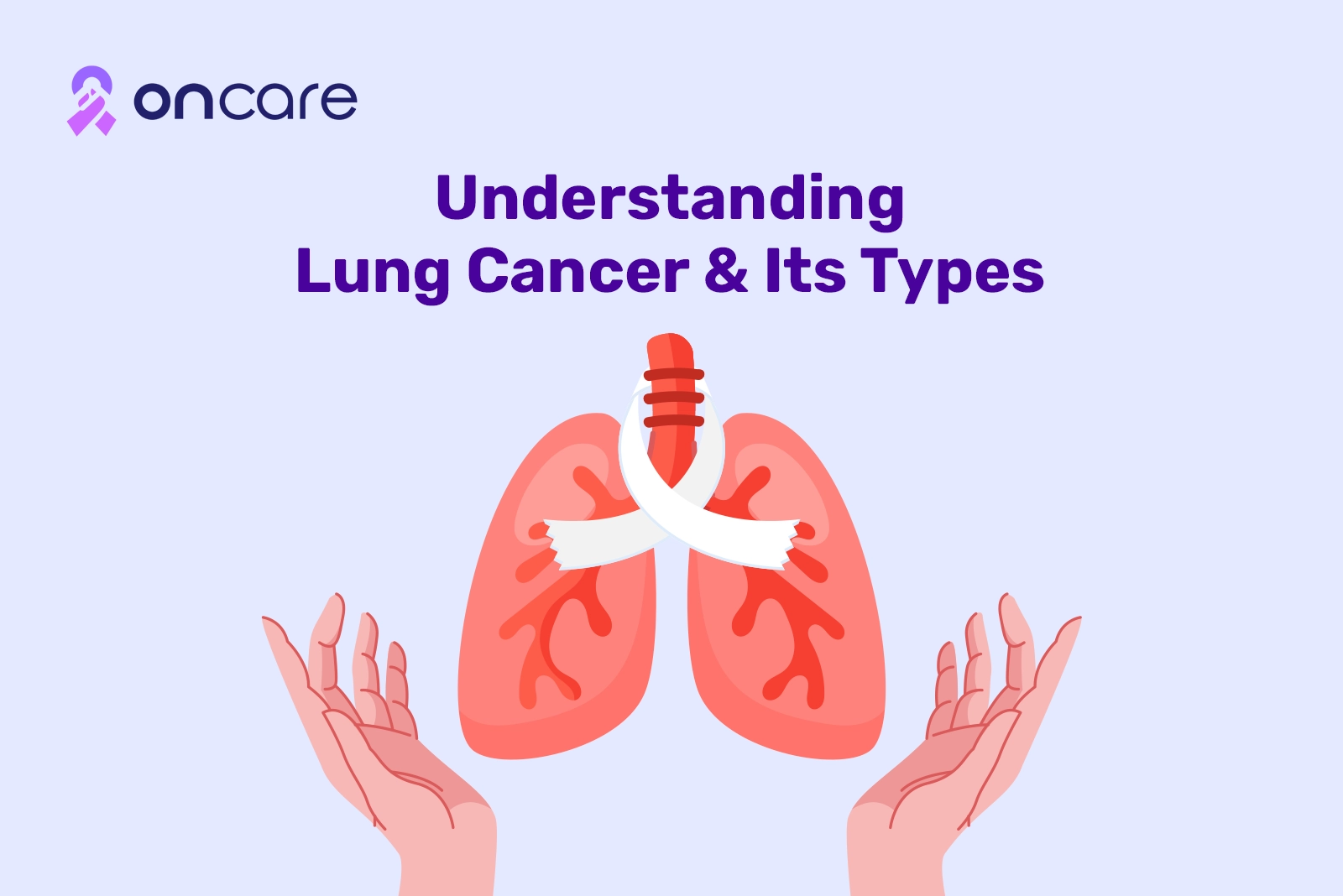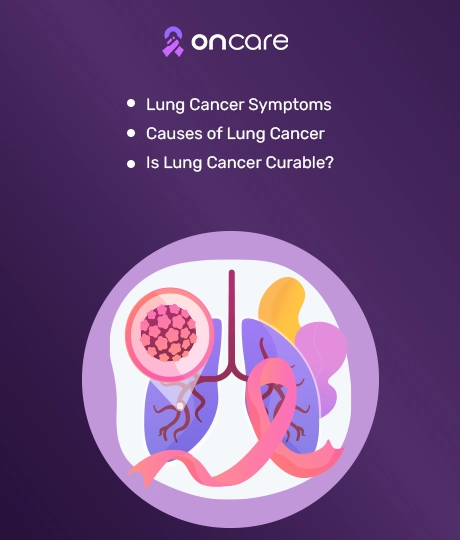Is Lung Cancer Curable? Learn About Its Types, Symptoms, and Causes

Lung cancer remains one of the leading causes of cancer-related deaths worldwide. It is caused due to the growth of harmful cells in the lungs. If left unchecked for a long time, your condition can deteriorate severely. Thus, understanding its types, symptoms, and causes is crucial for early detection and treatment. Lung cancer can be effectively treated through surgery, immunotherapy, chemotherapy, radiation, targeted drugs, etc.
With over 15 years of expertise in treating lung cancer, Oncare offers seamless treatments, including chemotherapy and affordable surgery plans. So, if you're navigating the challenges of lung cancer, we are here to support you every step of the way with personalized care. In this article, we explore lung cancer's complexities and how lung cancer symptoms can be identified early to give you the best chance at treatment.
Understanding Lung Cancer and Its Types
Lung cancer occurs when abnormal cells grow uncontrollably in the lungs, forming tumors that disrupt normal respiratory functions. It is broadly categorized into two types: Non-Small Cell Lung Cancer (NSCLC) and Small Cell Lung Cancer (SCLC). Each type differs in prevalence, behavior, and treatment approach. Here's an in-depth look at both.
Non-Small Cell Lung Cancer (NSCLC)
NSCLC is the most common form of lung cancer, accounting for approximately 85% of all cases. It encompasses several subtypes:
- Adenocarcinoma: Frequently diagnosed in non-smokers, adenocarcinoma originates in mucus-secreting glands. It is often detected in the outer regions of the lungs and tends to grow slower than other types, offering a better prognosis when caught early.
- Squamous Cell Carcinoma: This subtype is strongly linked to smoking and develops in the central part of the lungs, near the bronchi. Squamous cell carcinoma is often aggressive and may cause noticeable symptoms like coughing up blood.
- Large Cell Carcinoma: Known for its rapid growth, large cell carcinoma can appear anywhere in the lungs. It is more challenging to treat due to its aggressive nature.
Small Cell Lung Cancer (SCLC)
SCLC makes up about 15% of lung cancer cases and is characterized by its aggressive nature.
- Rapid Progression: SCLC grows and spreads quickly, often reaching advanced stages before detection.
- Smoking Association: Over 95% of SCLC cases are linked to heavy smoking, highlighting the importance of tobacco cessation programs.
- Limited vs. Extensive Stage: SCLC is categorized into limited (confined to one lung and nearby lymph nodes) and extensive (spread to distant organs) stages.
Both NSCLC and SCLC are classified into stages to assess the cancer’s spread.
- Stage I and II: Cancer is localized and has not significantly spread, making surgery a viable option.
- Stage III: Cancer may involve lymph nodes and require combined therapies.
- Stage IV: Cancer has metastasized to other organs, requiring systemic treatments like chemotherapy or targeted drugs.
Oncare excels in providing comprehensive staging of the different types of thyroid cancer and personalized treatment strategies for them. With cutting-edge diagnostic tools and a team of experienced oncologists, we ensure precision in diagnosis and care tailored to each patient’s needs.
Lung Cancer Symptoms
Lung cancer symptoms often vary based on the type, stage, and location of the cancer within the lungs. Early symptoms may be subtle and easily mistaken for common respiratory conditions, which makes early detection challenging. However, understanding the wide range of symptoms can help in recognizing the disease sooner. Here's an in-depth look at the symptoms of lung cancer, including subtle signs that may go unnoticed.
Early Symptoms of Lung Cancer
- Persistent Cough: One of the most common early symptoms, a persistent cough lasting more than two weeks may be a sign of lung cancer. Smokers often dismiss this as a "smoker's cough," which delays diagnosis.
- Mild Chest Pain: Early lung cancer may cause intermittent chest pain or discomfort. This is often mistaken for muscle strain or minor respiratory issues.
Advanced Lung Cancer Symptoms
- Coughing up Blood (Hemoptysis): As cancer progresses, tumors can cause bleeding in the airways, leading to blood in the mucus or phlegm, often referred as lung carcinoma symptoms. Even small amounts should be considered a medical emergency.
- Shortness of Breath: Tumors may block air passages or compress lung tissue, reducing oxygen exchange and causing breathlessness, especially during physical activity.
- Unexplained Weight Loss: Rapid, unexplained weight loss can be a sign of advanced cancer as the body's metabolism is disrupted by the disease.
- Fatigue: Constant tiredness, not relieved by rest, is a common symptom caused by cancer's effects on the body.
Systemic Symptoms
- Fever and Infections: Lung cancer patients may experience frequent lung infections, such as pneumonia or bronchitis, due to a compromised immune system.
- Bone Pain: Advanced lung cancer can metastasize to the bones, leading to pain, particularly in the back or hips.
- Headaches or Neurological Symptoms: If cancer spreads to the brain, it may cause headaches, dizziness, or vision problems.
Other Symptoms Specific to Tumor Growth
- Wheezing or Hoarseness: Tumors pressing on airways or nerves can lead to changes in breathing sounds and voice tone.
- Swelling of the Face or Neck: Obstruction of major veins due to tumor pressure can cause facial swelling, often referred to as superior vena cava syndrome.
- Nail Clubbing: Enlarged and rounded tips of fingers and toes may indicate reduced oxygen levels in the blood, a symptom linked to chronic lung issues, including lung cancer.
Many of these symptoms overlap with other conditions like asthma, chronic obstructive pulmonary disease (COPD), or lung carcinoma symptoms. However, the persistence or worsening of these symptoms over time warrants immediate medical attention. We at Oncare use comprehensive diagnostic tools, including advanced imaging and biopsies, to detect lung cancer at the earliest stage possible.

Causes of Lung Cancer
Lung cancer is primarily caused by the uncontrollable growth of abnormal cells in the lungs. Understanding the underlying causes can help with prevention, although it’s important to note that lung cancer can sometimes occur without any obvious risk factors.
The main causes of lung cancer include:
Tobacco Smoke
Smoking remains the number one cause of lung cancer. Approximately 85% of all lung cancer cases are attributed to smoking, whether directly or through exposure to second-hand smoke. The carcinogens in cigarette smoke damage the cells in the lungs, leading to cancer.
Environmental and Occupational Exposures
Exposure to certain chemicals and substances can increase the risk of lung cancer. Asbestos, radon gas, diesel exhaust, and air pollution have all been linked to lung cancer. For instance, people working in industries like construction or mining may face higher risks due to exposure to these carcinogens.
Genetic Factors
A family history of lung cancer may increase your risk, especially if you have relatives who have had the disease at a young age. Genetic mutations can cause abnormal cell growth, making some people more susceptible to lung cancer.
Age
The risk of lung cancer and symptoms increases with age, especially for individuals over the age of 60. Most lung cancer cases are diagnosed in people aged 65 or older.
Previous Lung Disease
Individuals who have had chronic lung diseases such as chronic obstructive pulmonary disease (COPD) or tuberculosis (TB) have an increased risk of developing lung cancer.
Exposure to Radioactive Materials
People exposed to radioactive substances like uranium and its byproducts are at higher risk of lung cancer. Miners and workers in nuclear facilities are particularly vulnerable.
Chronic Inflammation in the Lungs
Prolonged inflammation caused by infections, autoimmune diseases, or repeated lung injury can contribute to the development of lung cancer. This inflammation may damage lung tissue over time, creating an environment for cancer to grow.
Second-Hand Smoke
Non-smokers exposed to smoke from smokers are at risk. Around 7,000 deaths annually in the U.S. alone are linked to second-hand smoke.
Pollution in Urban Areas
High levels of urban air pollution, particularly from vehicles and industrial emissions, are associated with an increased risk of lung carcinoma symptoms. For instance, prolonged exposure to fine particulate matter (PM2.5) can damage lung cells.
Viral Infections
Certain viral infections, such as human papillomavirus (HPV) and Epstein-Barr virus (EBV), have been suggested as possible contributors to lungs with cancer, though these are rare.
Is Lung Cancer Curable?
The question of whether lung cancer is curable depends on several factors, including the type of lung cancer, the stage at which it's diagnosed, and how well it responds to treatment. While lung cancer is often diagnosed in later stages, it is treatable, and in some cases, it can be cured. Early-stage lung cancer has a higher chance of being cured, especially if it is localized to one area of the lung and hasn’t spread to lymph nodes or other organs. In such cases, surgery, along with chemotherapy or radiation therapy, can be effective.
At Oncare, our team of experienced oncologists first analyze your symptoms and then suggest any one or a combination of the following treatments.
- Surgery: Surgical removal of the tumor is the most common treatment for early-stage lung cancer.
- Chemotherapy: Chemotherapy uses drugs to kill cancer cells or stop them from growing. Our oncologists typically suggest it for advanced lung cancer or after surgery to eliminate any remaining cancer cells.
- Radiation Therapy: In this type of treatment, high-energy rays are used to target and kill cancer cells. Radiation is often used to shrink tumors before surgery or to ease symptoms in advanced stages.
- Targeted Therapy: This treatment targets specific genetic mutations or proteins in the cancer cells that are driving tumor growth.
- Immunotherapy: Our immunotherapy solutions help the body’s immune system recognize and destroy cancer cells more effectively.
While the outlook for individuals diagnosed with advanced lung cancer can be challenging, the latest medical advancements, including immunotherapy and targeted therapies, have shown promise in improving survival rates. Our oncologists thus provide personalized treatment plans for lung cancer patients, ensuring the best possible care tailored to their specific needs.
Conclusion
Lung cancer is a serious disease, but it is treatable, especially when detected early. The course and duration of the treatment that you will have to undergo typically depends on the type and stage of your cancer. Hence, it is important to consult a doctor as soon as you start experiencing the symptoms.
Dealing with cancer is a rollercoaster of emotions, but a team of experienced oncologists can make your journey seamless and hassle-free. Oncare is committed to offering effective treatment options for patients battling lung cancer, with an expert team to guide you through every stage of your journey.
Frequently Asked Questions (FAQs)
Early-stage non-small cell lung cancer (NSCLC) is the most curable type, especially if diagnosed before it spreads.
Yes, symptoms may fluctuate, but persistent symptoms that worsen over time should not be ignored.
Early detection through screening can help stop lung cancer before it spreads, improving the chances of successful treatment.
Yes, with the right treatment plan, many patients can fight lung cancer and improve their survival rate, especially if detected early.
A healthy diet rich in antioxidants, vitamins, and minerals, such as fruits and vegetables, may lower the risk of lung cancer symptoms. Avoiding smoking and environmental toxins is also crucial.
Pain can vary based on the cancer's stage, with advanced stages causing significant discomfort. Treatment options can help manage the pain.
While a complete cure is possible for early-stage lung cancer, advanced stages may not be curable, though treatment can still extend life and alleviate symptoms.
Pancreatic cancer is considered one of the fastest-killing cancers due to its rapid spread and late detection.
The finger test involves checking for clubbing of the fingers, a symptom of lung cancer in some cases caused by a lack of oxygen in the blood.